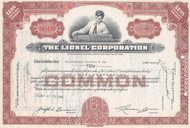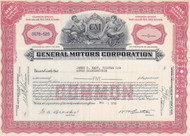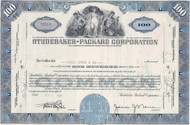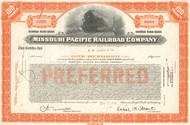Categories
Categories
- Home
- Railroad
- Modern Railroads
- Baldwin-Lima-Hamilton Corporation 1950's
Baldwin-Lima-Hamilton Corporation 1950's
Product Description
Baldwin-Lima-Hamilton Corporation stock certificate 1950's
Great vignette of the company's founder, Matthias Baldwin. Hard to find railroad collectible. Issued and cancelled. Dated 1950's.
Lima Locomotive Works was an American firm that manufactured railroad locomotives from the 1870s through the 1950s. In 1947, the firm merged with General Machinery Corporation of Hamilton, Ohio, to form Lima-Hamilton. In 1951, Lima-Hamilton merged with Baldwin Locomotive Works to form Baldwin-Lima-Hamilton (BLH). The Lima-Hamilton line of Diesels was discontinued, in favor of Baldwin's existing line. B-L-H continued to produce machinery under all three brand names; in the mid-1960s, it also introduced a line of wheel loaders and a small crawler asphalt paver bearing only the BLH brand. Armour & Company acquired B-L-H as a subsidiary in 1965, and sold all of the construction equipment lines to Clark Equipment Company in 1971.
The Baldwin Locomotive Works was an American builder of railroad locomotives. It was originally located in Philadelphia, and later moved to nearby Eddystone, Pennsylvania. Although the company was very successful as the largest producer of steam locomotives, its transition to the production of diesels was far less so. Later, when the early demand for diesel locomotives to replace steam tapered off, Baldwin could not compete in the marketplace. It stopped producing locomotives in 1956 and went out of business in 1972, having produced over 70,000 locomotives, the vast majority powered by steam.
In 1831, at the request of the Philadelphia Museum, Matthias W. Baldwinbuilt a miniature locomotive for exhibition which was such a success that he received that year an order from a railway company for a locomotive to run on a short line to the suburbs of Philadelphia. His first locomotive, christened Old Ironsides, was completed and tried on the Philadelphia, Germantown and Norristown Railroad on November 23, 1832. It was at once put in active service, and did duty for over 20 years.
In the 1850s, railroad building became a national obsession, with many new carriers starting up, particularly in the Midwest and South. While this helped drive up demand for Baldwin products, it also increased competition as more companies entered the locomotive-production field. Still, Baldwin had trouble keeping pace with orders and in the early 1850s began paying workers piece-rate pay. Taking advantage of human nature, this increased incentives and productivity. By 1857, the company turned out 66 locomotives and employed 600 men.
By the time Matthias Baldwin died in 1866, his company was vying with Rogers Locomotive and Machine Works for the top spot among locomotive producers. By 1870 Baldwin had taken the lead and a decade later, it was producing 2½ times as many engines as its nearest competitor. The American railroad industry expanded significantly between 1898 and 1907, with domestic demand for locomotives hitting its highest point in 1905. Baldwin’s business boomed during this period while it modernized its Broad Street facilities. From 1904 Baldwin and Westinghouse marketed Baldwin-Westinghouse electric locomotives and A.C. electrification of railroads.
Baldwin was an important contributor to the Allied war effort in World War I. Baldwin built 5,551 locomotives for the Allies including separate designs for Russian, French, British and United States Trench railways. Baldwin built railway gun carriages for the United States Navy and manufactured artillery shells for Russia, England and the United States. From 1915 to 1918, Remington Arms subcontracted the production of nearly 2 million Pattern 1914 Enfield and M1917 Enfield rifles to the Baldwin Locomotive Works.
After World War I, Baldwin's business would decline as the diesel engine became the standard on American railways. By the 1920s the major locomotive manufacturers had strong incentives to maintain the dominance of the steam engine. Baldwin began an attempt to diversify its product line in 1929, but the Great Depression thwarted these efforts and Baldwin declared bankruptcy in 1935.
When Baldwin emerged from bankruptcy in 1938 it underwent a drastic change in management.The new management was dedicated to diesel power but the company was already too far behind. Business declined drastically in the postwar years as EMD and Alco seized the bulk of the diesel market from Baldwin, Lima-Hamilton and Fairbanks-Morse.
During World War II Baldwin's contributions to the war effort included not only locomotives and switchers but also tanks. Baldwin was one of the manufacturers of several variants of the M3 tank and later the M4 Sherman. Between 1940 and 1948, domestic steam locomotive sales declined from 30 percent of the market to 2 percent. By 1949, there was no demand for steam locomotives. In a move to diversify its operations Baldwin merged with Lima-Hamilton on December 4, 1950, to become Baldwin-Lima-Hamilton.
In 1956 the Pennsylvania Railroad (PRR)- which was slow in accepting diesels- finally decided to retire its steam fleet, which was the largest in the world at that time, and buy a large order of diesels. Baldwin bid, expecting its lifelong loyal customer to help keep Baldwin in business by buying at least some Baldwin diesels. General Motors' EMD division, however, gave the PRR an exceptional deal on new, reliable GP9s, so the PRR— which was in a financial pinch itself— sent the business to GM. This one lost deal proved to be the end of the line, and, after 125 years of continuous production, Baldwin closed most of its Eddystone plant. It produced no more locomotives after 1956, instead concentrating on heavy construction equipment. More than 70,500 locomotives had been produced when production ceased in 1956.
In 1965 Baldwin became a wholly owned subsidiary of Armour and Company. Greyhound Corporation purchased Armour and Company in 1970, and in 1972 Greyhound closed Baldwin-Lima-Hamilton for good.
 Loading... Please wait...
Loading... Please wait... 









